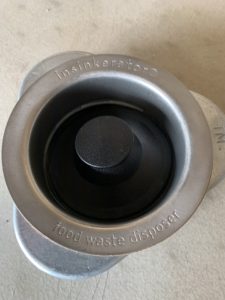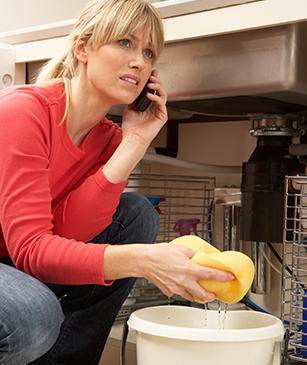We have found this article pertaining to Why Is My Garbage Disposal Leaking From the Bottom? below on the net and figured it made sense to share it with you here.

Garbage disposals are crucial kitchen area home appliances that assist in disposing of food waste efficiently. Nevertheless, a leaking garbage disposal can be a discouraging and messy trouble to deal with. Thankfully, many leaks can be taken care of quickly with a few easy actions. In this short article, we will certainly go over exactly how to deal with a dripping waste disposal unit successfully.
Introduction
Garbage disposals are mounted under cooking area sinks and are created to shred food waste right into smaller pieces, permitting it to travel through the plumbing system easily. While these tools are normally trustworthy, leakages can happen in time due to deterioration, loosened links, or damage to the system.
Usual Root Causes Of Leaks in Garbage Disposals
Worn Seals and Gaskets
Seals and gaskets play a vital role in avoiding water from leaking out of the garbage disposal. In time, these parts can deteriorate, leading to leakages around the disposal device.
Loose Connections
The links between the waste disposal unit and the plumbing system can end up being loose over time, triggering water to leak out throughout operation.
Splits or Holes in the Disposal Device
Physical damage to the waste disposal unit, such as splits or openings in the housing, can also result in leakages.
Determining the Source of the Leak
Before attempting to repair a dripping garbage disposal, it is vital to determine the source of the leakage. This can generally be done through visual examination or by conducting basic tests.
Visual Evaluation
Examine the waste disposal unit system meticulously for any type of indications of water leakage. Pay very close attention to areas around seals, gaskets, and connection factors.
Testing for Leaks
One method to examine for leaks is by running water through the disposal unit and checking for any kind of noticeable indications of leakage.
Tools and Products Needed for Dealing With a Dripping Waste Disposal Unit
Prior to starting the repair process, gather the needed devices and materials, including a screwdriver, flexible wrench, plumbing professional's putty, substitute seals or gaskets, and epoxy or patching product for fixing fractures or openings.
Step-by-Step Guide to Fixing a Leaking Waste Disposal Unit
Switch off the Power
Prior to attempting any repair work, guarantee that the power to the garbage disposal unit is turned off to prevent the threat of electric shock.
Situate the Leakage
Recognize the precise place of the leakage and establish the reason.
Tighten Connections
Make use of a wrench to tighten up any type of loose links between the disposal device and the pipes system.
Replace Seals or Gaskets
If the leak is due to worn seals or gaskets, remove the old components and replace them with brand-new ones.
Patching Cracks or Openings
For fractures or holes in the disposal unit, usage epoxy or an ideal patching product to seal the damaged location.
Examining the Waste Disposal Unit After Repair Service
Once the repair is complete, examine the waste disposal unit by running water through it to ensure that the leak has been fixed.
Preventive Maintenance Tips to Stay Clear Of Future Leakages
To stop future leaks, it is vital to perform normal maintenance on your waste disposal unit. This includes keeping it tidy, preventing putting non-food products or hard items down the disposal, and occasionally looking for leakages or various other problems.
Verdict
To conclude, repairing a dripping waste disposal unit is a reasonably straightforward process that can be finished with fundamental devices and materials. By following the steps outlined in this article and practicing preventive upkeep, you can keep your garbage disposal in good working problem and avoid expensive repair work in the future.
What to Do About a Leaking Garbage Disposal
A leaking garbage disposal often goes unnoticed until you confront a sopping cabinet, a foul-smelling puddle, or an audible drip-drip-drip from the unit. The fix can be frustrating, too, because the leak can stem from a number of components in the system. Fortunately, with a little sleuthing, you can zero in on the leak and—depending on the exact location—stop the icky oozing and repair the component that caused it. Worst case scenario, if it turns out that the garbage disposal must be replaced, installing a new one is a reasonable do-it-yourself task for those with basic plumbing skills. Read on to keep the cash you’d otherwise hand over to a pro.
Prepare to find the leak
Prior to testing the garbage disposal for leaks, unplug it at the wall outlet and turn off the power from the breaker box to prevent electrical shock. Then insert a watertight sink stopper into your sink drain and wipe the unit dry with a clean cloth. In any handy container, mix a few drops of food coloring into a few cups of water, and pour the dyed water onto the sink stopper to help you locate the leak.
Investigate the source
- the top, where the disposal meets the sink drain
- the side, where the dishwasher hose or main drain pipe connects to the disposal
- or the bottom of the unit
Inspect each of these locations while gliding a light-colored rag over the unit; the dyed water will readily show on the rag and reveal the location of the leak. If a leak isn’t immediately apparent, remove the sink stopper and pour a few more cups of dyed water down the sink drain, then check for leaks again. Leaks near the top of the unit are more likely to show themselves while the sink is plugged, while side and bottom leaks are more noticeable while the sink is unplugged.
The metal sink flange that sits directly inside the sink drain is typically sealed around the top with plumber’s putty (a clay-like sealant) and then secured from under the sink with bolts. If the plumber’s putty deteriorates, or the bolts loosen, the flange can no longer form a watertight seal between the sink drain and the disposal—which could cause a leak at the top of the unit.
To reseal the leaky flange, you must first detach the garbage disposal. Start by loosening the screws securing the main drain pipe to the disposal, then loosen the screws in the metal clamp securing the dishwasher hose to the disposal and detach the drain pipe and dishwasher hose from the disposal. Loosen the screws in the mounting ring that connects the disposal to the metal mounting assembly beneath the sink, then pull down the disposal and carefully set it on a clean, dry surface. Loosen the bolts in the mounting assembly with a wrench, then pull down the mounting assembly and set it near the disposal.

We had been shown that report on Why Is My Garbage Disposal Leaking From the Bottom? from a good friend on a different blog. Remember to take the time to distribute this article if you enjoyed it. We treasure reading our article about Why Is My Garbage Disposal Leaking From the Bottom?.
Course Detail
Comments on “Simple Techniques for Repairing a Leaky Garbage Disposal”